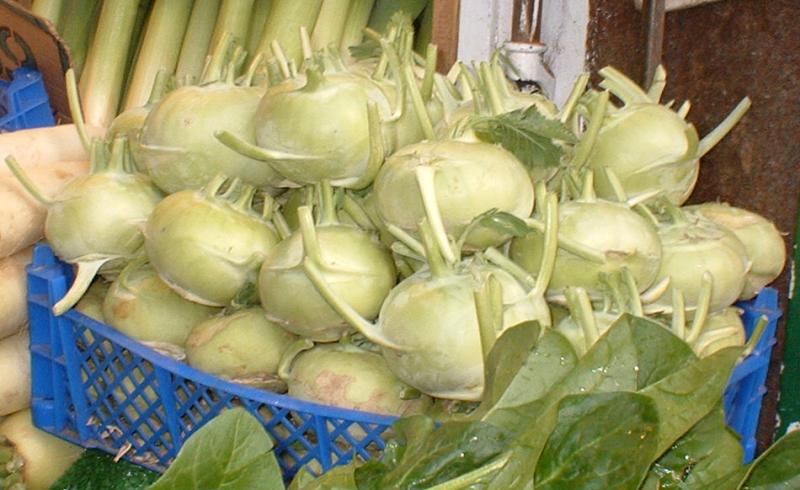- Kohlrabi
Infobox Cultivar | name = Kohlrabi

image_width = 240px
image_caption = Kohlrabi stems with leaves removed
species = "Brassica oleracea "
group = Gongylodes Group
subdivision = many; see textKohlrabi (German Turnip) ("
Brassica oleracea " Gongylodes Group) is a low, stoutcultivar of thecabbage that will grow almost anywhere. It has been selected for its swollen, nearly spherical, Sputnik-like shape. The name comes from the German "Kohl" ("cabbage") plus "Rübe" ~ "Rabi" (Swiss German variant) ("turnip"), because the swollen stem resembles the latter.However, the actual "Kohlrübe" exists too and corresponds to therutabaga in English, which the kohlrabi is not to be confused with. Kohlrabi has been created byartificial selection for lateralmeristem growth; its origin in nature is the same as that ofcabbage ,broccoli ,cauliflower ,kale ,collard greens , andbrussels sprouts : They are all bred from, and are the same species as, thewild cabbage plant ("Brassica oleracea").The taste and texture of kohlrabi are similar to those of a
broccoli stem or cabbage heart, but milder and sweeter, with a higher ratio of flesh to skin. The young stem in particular can be as crisp and juicy as an apple, although much less sweet. Except for the Gigante cultivar, spring-grown kohlrabi much over 5 cm in size tend to be woody, as do fall-grown kohlrabi much over perhaps 10 cm in size; the Gigante cultivar can achieve great size while remaining of good eating quality.Kohlrabi can be eaten raw as well as cooked.
There are several varieties commonly available, including White Vienna, Purple Vienna, Grand Duke, Gigante (also known as "Superschmeltz"), Purple Danube, and White Danube. Coloration of the purple types is superficial: the edible parts are all pale yellow. The leafy greens can also be eaten.
Some varieties are grown as feed for
cattle . [ Bailey, L. H., (1912, republished in 1975). Kohlrabi for stock-feeding. In " [http://books.google.com/books?id=VtuQyY88CEsC&printsec=frontcover&sig=9rT_B0dkatElsxyFJ1O7-hXiJ7I&source=gbs_book_other_versions_r&cad=3_1#PPA389,M1 Cyclopedia of American Agriculture: Vol. II--crops] ". Macmillan Publishing, New York. p. 389-390. ISBN 0405067623. Google Book Search. Retrieved on June 15, 2008.]Kohlrabi is one of the most commonly eaten vegetable in Kashmir. Locally called Monj, the vegetable is eaten along with the leaves. Every Kashmiri household will have this on their dinner/lunch plate 3 to 4 times a week. In India the vegetable is available in Pune, Delhi, Bangalore, Mumbai, Amritsar, Chandigarh among other cities.
Monj (kohlrabi) is made in many forms. There is a spicy version which the Pandits call "dum monj" while as the non-spicy version is called Monj-haakh.
Alternative Names
*
Arabic "الورديّة" (Al-Wardia)
* Ganth-gobi "Up-Bihar"
*Kannada "Navil Kos"
*Marathi "Naval Kol"
* Punjabi/dogri "Kadam"
* Tamil "Nool Kol"* In Maharashtra (India), Kohlrabi is called "Naval-khaval". People in Maharashtra, usually, do not eat the leaves of Naval Khaval.
ee also
*
Rutabaga
*List of culinary vegetables External links
* [http://database.prota.org/dbtw-wpd/exec/dbtwpub.dll?AC=QBE_QUERY&BU=http%3A%2F%2Fdatabase.prota.org%2Fsearch.htm&TN=PROTAB~1&QB0=AND&QF0=Species+Code&QI0=Brassica+oleracea+kohlrabi&RF=Webdisplay PROTAbase on "Brassica oleracea (kohlrabi)"] [http://aggie-horticulture.tamu.edu/plantanswers/publications/vegetabletravelers/kohlrabi.html Kohlrabi and Brussels Sprouts Are European]
* [http://www.ibiblio.org/pfaf/cgi-bin/arr_html?Brassica+oleracea+gongylodes Kohlrabi] : Plants For a Future database
* [http://www.gretchencooks.com/recipes/411_Spicy_Kohlrabi Spicy Kohlrabi recipe]References
Wikimedia Foundation. 2010.
